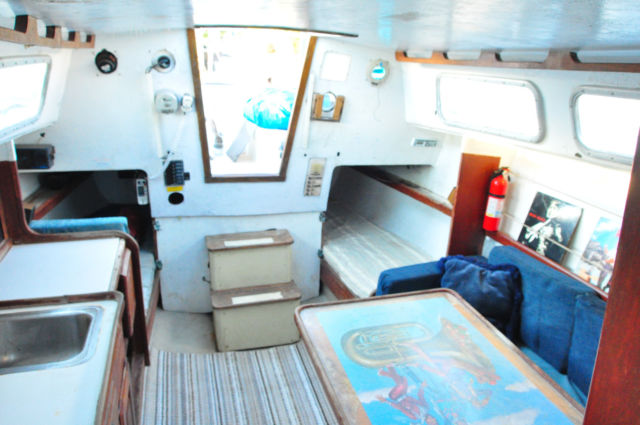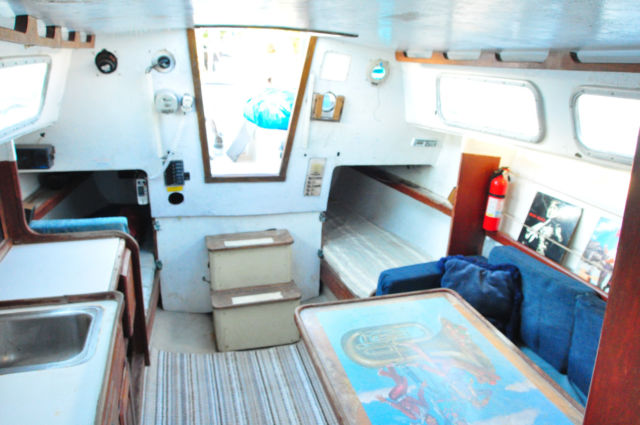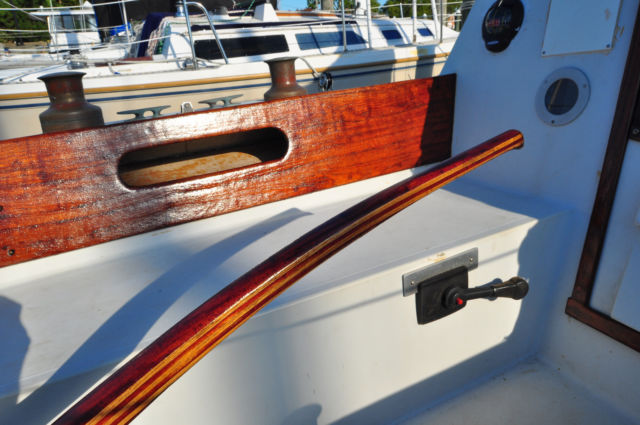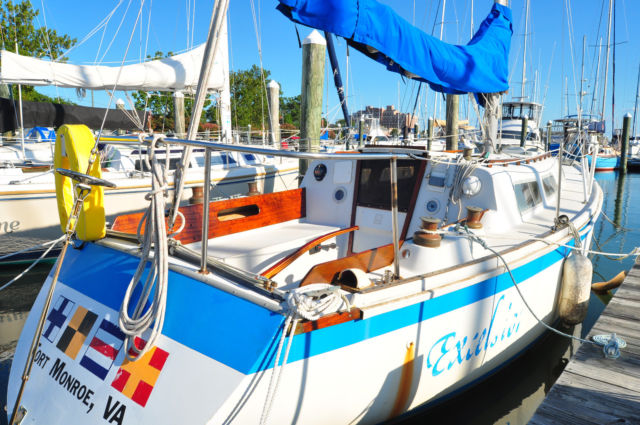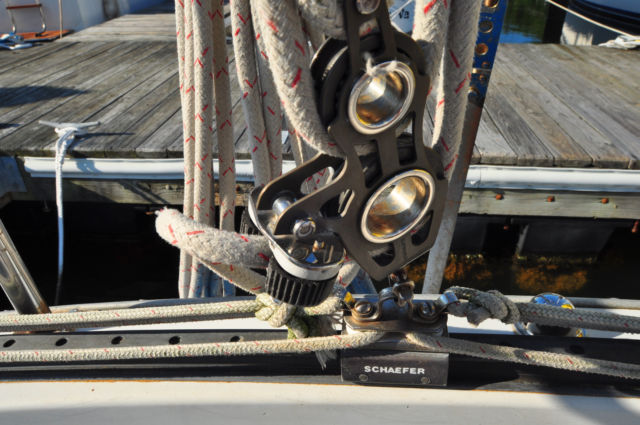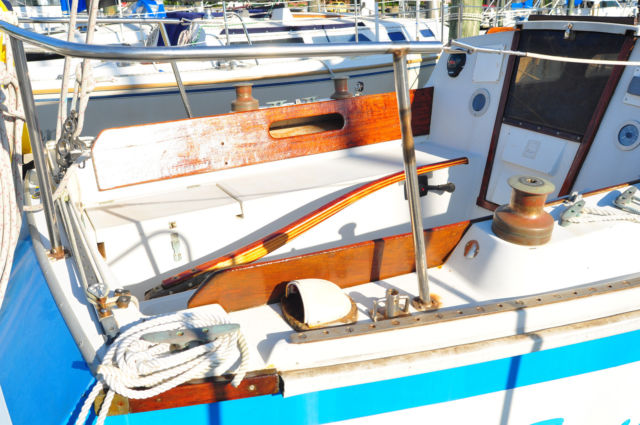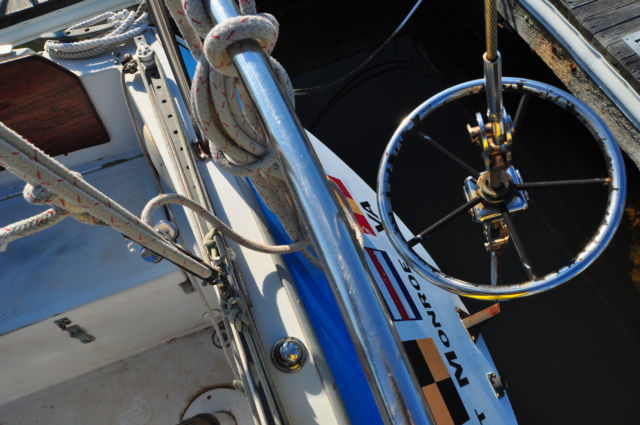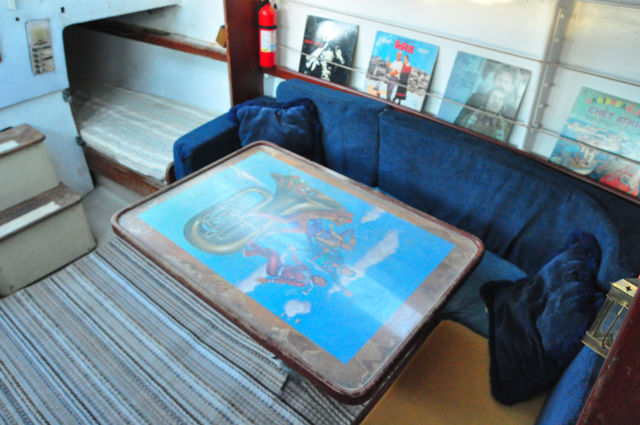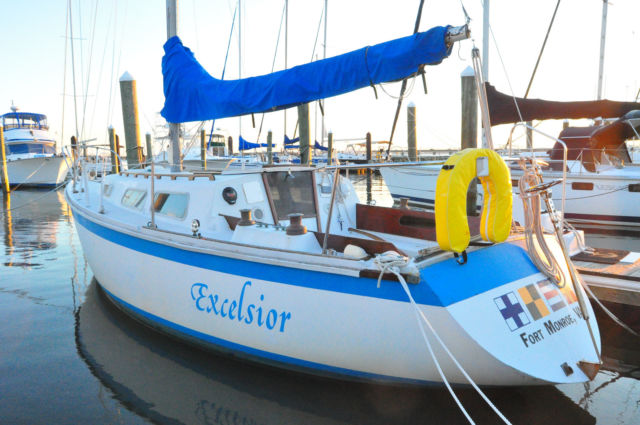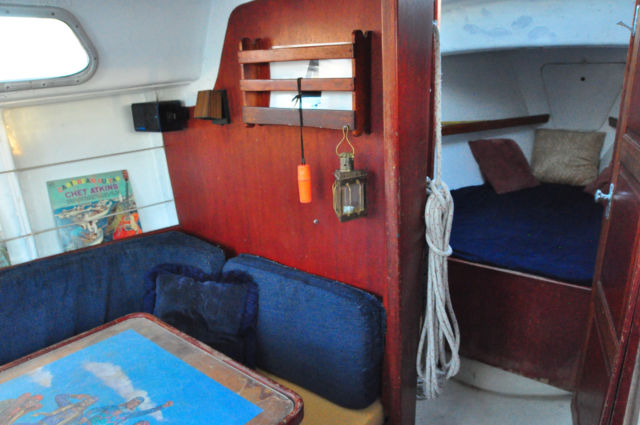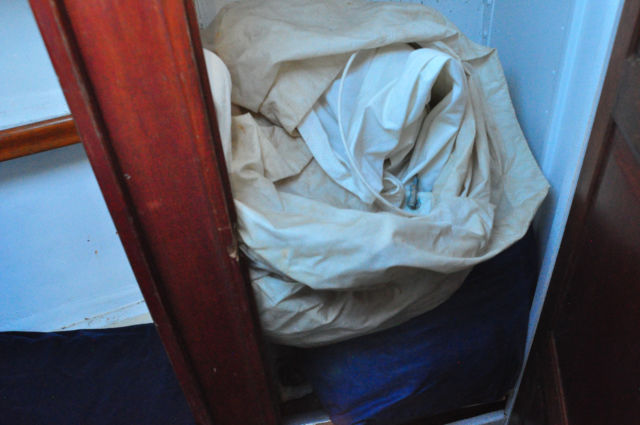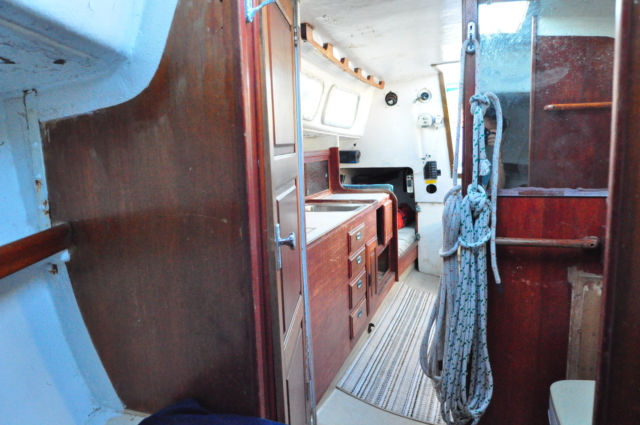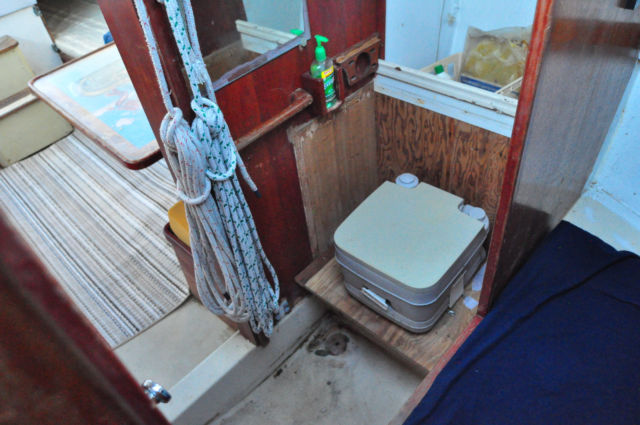NO RESERVE - Rugged Medium Size Global Cruiser XLent Single Handing/Couple CAL30
1971 JENSEN MARINE Jensen CAL 2-30
- Price: Contact seller
- Make: JENSEN MARINE
- Model: Jensen CAL 2-30
- Type: Cruiser
- Year: 1971
- Location: Fort Monroe, Virginia, United States
Description
Uniden Oceanis submersible vhf radio
Ray marine st40 BDATA Depth Sounder
Danforth globe compass
Contest Globe Compass
Barlow Brass winches 5 on-deck and one on mast
Full Length to Transom Main Sail (Good Used Condition - Estimated Value $500)
100% Jib (Good Used Condition - Estimated Value $400)
125% Genoa (Good Used Condition - Estimated Value $500)
Jim buoy Throwable Type IV PFD
Tensioning back stay
Schaefer 4 to 1 Main Block Tackle and Full width traveler with locking cleats
Kenyon KSI knot meter
All lines run to cockpit through easy lock jam cleats
Stainless ball bearing genoa blocks on extra long sliding rails
Nice sail cover
Stereo system with West marine water resistant speakers
Three stage boat pole
Universal Engine Instruments Console
On Jul-31-17 at 08:05:45 PDT, seller added the following information:
TERMS OF THE AUCTION:
Please read the entire auction text and study the photos so that you can be a fully informed bidder. If it is possible for you, also please come and check out the boat in the real world. That is the best way to truly get an accurate idea of whether the boat will meet your needs and expectations. Please place bids based on what funds you have available on-hand or on credit cards etc. PAYMENT IS DUE IN FULL WITHIN 24 HOURS. PLEASE CONSULT YOUR SPOUSE OR BOAT PARTNER(S) BEFORE MAKING THE COMMITMENT TO MAKE A PURCHASE. YOUR BID IS A LEGALLY BINDING CONTRACT TO PURCHASE THIS CLASSIC VESSEL, SO DO YOUR HOMEWORK AND MAKE CERTAIN THAT IT IS THE RIGHT CRUISING YACHT TO SUIT YOUR NEEDS AND BUDGET. If you have questions to ask about the boat I will be happy to speak with you on the phone, or if you wish to schedule a boat tour before the auction closes, please give me a shout.
William 970 319-4361
In 1968 a teenager from Los Angeles named Robin Lee Graham, set out in a 24 foot foot sloop named "Dove." He began a multi-year voyage circumnavigating the entire planet..."SOLO!!" This was the era before GPS. He navigated with charts and a sextant. Recreational craft did not have Radar or SSB internet for weather forecasts or satellite phones or EPIRBs. He did have a short range VHF radio, but primarily his only survival tools were his own wits and the strength of the boat he was sailing in. He didn't even have an inboard motor--just a tiny outboard to help him power into tight anchorages with just a few gallons of fuel. What he did have was good training by experienced sailors, and a lot of courage.
If you want to read about his voyage you can buy the classic book on Amazon or Ebay published by National Geographic "The Boy Who Sailed Around the World Alone." It's a cheap book. You ought to read it. Robin also published his own more lengthy account under the title of "Dove." If you are one of those people like me who has bookshelves of old National Geo magazines in the living room, you can find several great articles about his voyage that were featured during the course of his journey. By the time he returned to his home port in California, completing the circumnavigation, he had set a new record as the youngest person to ever solo circumnavigate. He beat the previous record by like 30 years or something, because you could count on your fingers the total number of solo circumnavigations made by humans prior to that time, and prior to him everyone who had done it already had decades of blue water knots under the keel.
The reason I mention this story is because of the boat he sailed. He could not afford any of the extremely customized luxury yacht brands so he chose the very best production sailboat available...a boat built by Jensen Marine.
There are about 40 or more companies that have built sailboats over the decades with production runs of hundreds of hulls. There are hundreds of companies that built just single digits or a few dozen hulls. Of all the companies that came and went the best boats were built during what we call the "classic plastic" era when they used heavy FRP lay-ups with high glass to resin ratios and long strand rolls of woven roving fiberglass cloth rather than the later (and much cheaper method) of blown chipped fiberglass matt with excessive resin to glass mixtures. Go figure, today if you built a Jensen Cal 30 foot sloop to the original specifications, the cost of fiberglass and cloth alone would be about $25,000. That is because the fiberglass is much more expensive than the resin by weight, but also much stronger. the long strand cloth is what gives a hull the strength to resist oil-canning and hull flex and stress fractures when sailing in tough conditions on blue water passages. Of all the companies that built boats most were designed for moderate weather coastal cruising and lake sailing. But the best brands of the middle class boats cost about twice as much as the average Hunter off the assembly line, because the labor and materials was so much more expensive. The three brands which I really consider about the best of all the major 40 brands are Jensen Cal, S2 and Dufour. These boats are not as fancy as some of the other coastal cruisers, but they will save your life in a storm and they sail incredibly well, even in harsh conditions.
A Little About Us:
We are the Founder's of Cruising Consultants Inc. Our passion is to assist folks who are making a transition from day sailing or coastal cruising to becoming full-time live-aboard world cruisers. We also assist new sailors who are just getting into the sport of sailing by advising them on how to develop their skills and how to make plans to pursue the dream of cruising and world traveling full-time.
We have extensive contacts and resources for finding good world cruising boats at far below their fair market value, and occasionally we discover an amazing neglected vessel at a price that we know may enable a cruising family or a retired couple on fixed income the ability to pursue the dream of cruising without the sort of means and savings normally associated with pursuing this lifestyle.
In those cases, like this boat, we work to try and find a new home for a good “below market value” boat, with people who will fully restore the vessel, and hopefully use it for the serious cruising that the boat was designed for.
There are many aspects of life where experience really matters, but none so much as global cruising. When you are planning to take a small boat across vast oceans and visit foreign ports of call on your own terms you must truly learn to become Master's of your Own Destiny. It doesn't matter how wealthy you are or how talented you are at managing large organizations or companies with dozens of staff people.
When you are on a boat in the middle of the ocean, the choices you have made, the choices you will make and your own internal skills and the undeniable truth of how well or poorly you have planned for your expedition, are the factors that will determine whether your experiences become a positive adventure or a frightening (or even life threatening) catastrophe.
When you are looking at a boat parked peacefully at a dock or on jack stands at a boat yard, you will be tempted to judge it based on whether the lines are nice and whether it is pretty or ugly and whether it is new or old and well kept or run down.
The ocean however, operates according to immutable laws of physics. The ocean does not care whether it sinks a pretty boat or keeps an ugly one floating. It does not care whether you are a skilled sailor with dozens of years experience under your shade hat or whether you are an amateur on your first weekend pleasure cruise. You will be served exactly the same conditions of wind and waves whether you were born wealthy or if you were raised in a cave by baboons.
The only control you have over these situations is knowing when to sail and when not to sail, and you can prepare yourself so that when the wrong situation strikes, if it ever does, you are skilled and prepared to deal with it and have a vessel that is prepared to handle the same.
For people who are wanting to go cruising full-time, or who want to go from being pleasure sailors to competent seamen and seawomen, choosing the right boat is the first and sometimes ultimately most important decision of their nautical lives.
Of course you can always sell or trade a boat and then buy a different one, but still the choice of each boat will influence the experiences you have and it will determine in many ways the capabilities or limitations of what you can or can't do while you have that boat for your home—even if it is only home for a few weekends here and there.
There are many nuances and subtleties to sailing, as well as to each individual vessel. A boat that may be just exactly perfect for one sailor or family of sailors, may be completely the wrong boat to suit another person's dreams.
By nature, boats require a lot of maintenance and upgrades, and if you are someone who wants all the possible bells and whistles, boating can be a very expensive occupation.
However, there are also ways to save a lot of money and still pursue the dream effectively and safely create a new floating paradise for yourself. But each person or each couple's needs are different.
There is no such boat as a boat that is not a project boat.
Long before we were married, when my wife was only 12 years old, and her father (a relatively wealthy man at the time) purchased a brand new Beneteau 46 for the family to live on for years, and to cruise the world on, the first thing he did to a brand new half million dollar boat was to spend another $27K on equipment upgrades, new electronics installations and custom modifications.
The reason he did that is because no boat, no matter how shiny and brand new, is exactly right for everyone's individual tastes and needs, and no boat comes straight from the factory completely ready to do anything other than Wednesday afternoon beer can races.
I often get asked by people who are shopping for a used boat to go cruising the world, “Is this boat ready to cross the Atlantic?” or “Does it need anything before it is 'Ready to Sail.”
The very nature of that question is a showcase of their naivety. Even if the answer were “Yes, the boat is ready.” (which would be impossible to have any boat ready unless you have spent thousands of dollars on a cruising chandlery and provisioning service ahead of time) the greater question is “Are such novice sailors who need to ask such questions ready themselves?”
Even if they had the absolutely perfect boat, prepared ahead of time by die-hard professionals to get it ready to cast off the lines and sail to points distant and exotic, would the sailors know where everything is at on the boat and how to operate those systems and how not to break them with ignorant mistakes or how to fix them once broken? And if they knew all those things, would the boat be equipped with the necessary repair tools and supplies as part of the process of getting it ready to sail?
So all these are big questions, and the only easy answer is that any sailor must become intimately familiar with their vessel prior to making long voyages beyond sight of land. The easiest way to become familiar with a boat so that it is not a stranger but rather a trusted old friend is to do a lot of weekend coastal cruising with it, while you work all the bugs out. Also, the more projects and upgrades you do yourself the more familiar you will be with how they work, how to maintain them and how to fix them again if anything every goes wrong. To depend on the expertise of professionals left behind in a port in a distant country you cleared out of months ago is only to invite future disaster...and its also much harder on the wallet.
So any time you can add to your own skills and knowledge of your own boat by doing your own work, or hiring a professional to help you do it yourself, you are preparing yourself for future success as a cruiser.
Any boat, even a brand new boat, will have things about it that you want to change or upgrade or move or install prior to making long voyages.
The better questions to ask are:
“What is the proper amount of maintenance and upgrades that I will make to my vessel prior to setting sail?
How many things need to be changed or fixed before I leave the continental US?
How many projects will I work on, as little projects along the way, when I have a slow day at a boring anchorage and there are no cruiser parties to attend and no interesting conversations of the side channels of the VHF.
How many projects are absolutely vital to get accomplished before I begin actively using the boat as a full time residence and a floating RV that can sail to any country with a coastline?”
How many projects do I want to tackle myself if it means I can save literally tens of thousands of dollars on the purchase price of a boat, and how much more ultimate value do I get for my money by buying a larger or more seaworthy boat with a few bigger projects to tackle, than if I buy a smaller or more flimsy boat that is cleaned up nicer and has fewer problems to address. (Remember the ultimate cosmic law of boating – even if you can't see any problems at all with a boat, and no projects needing doing, as soon as you own it and begin to sail it, you will start to find those quirks and bugs) So don't fool yourself into believing that you can simply buy a shiny new boat from a broker at full market value, or even by paying more than boat blue book value, to avoid ever having to make repairs or upgrades.
Any experienced sailor or boating professional other than someone selling fancy new boats will admit to you that there is no such boat other than a “project boat.” The only question is “What are the projects and how much money will I save by doing them myself versus hiring someone else to complete them?”
Every boat that I have ever bought or ever sold, which is now many dozens of them, had varying degrees of things needing to be improved about it. Even the brand new boats straight from the showroom floor or boat show sales dock will need bottom painting and new zincs and fuel cleansing treatments and oil changes and manifold and riser inspections within a matter or months of casual weekend use.
The longer any boat sits without the proper level of loving regular maintenance the faster it will deteriorate, and tiny 15 minute projects will turn into hour-long projects and hour-long projects will turn into day-long or week-long projects due to continuing neglect.
The quality of the build is also important. A cheap boat will have cheap boat problems, and it will have serious issues far faster and more frequently than a very well built boat from an esteemed yacht designer and builder even if the better boat looks worse initially.
In many ways you are better off to buy an older and more well regarded vessel in worse “first impressions” condition than to buy a shiny and well kept cheaper new boat. In the long run the better boat will cause far fewer headaches once you have it restored fully and you are taking care of it yourself, whereas the cheap but glossy boat may still look new and shiny for years, but begin having serious and costly problems that cannot be seen even while it still looks great in Facebook boat pictures.
Boating is like riding a horse or driving a high performance sports car. You always have to be involved in the life of your boat whether you use it frequently or not.
But this is not a bad thing, because it is part of the pride of ownership, and the regular maintenance and upkeep and small projects is what enables you to avoid the big ones or to at least know which big ones you need to do sooner and which ones can wait till later.
As you will guess by now, I'm a bit of a philosopher sailor when it comes to helping folks find just the right boat to serve their needs.
I am currently writing a book on that very topic which will be called, “The Seven Questions of Cruising (or) the Seven Questions you should ask yourself before buying a Boat.” Here is a quick preview of the questions you should be trying to answer from the introduction to my new book.
When you go to buy a boat, especially if it is your first boat, there are a lot of decisions to be made and hard choices to figure out.
Before you begin searching for the correct vessel to serve your needs, you need to first ask yourself, (and your cruising partners/ spouse etc) some important questions which will help you immensely in the quest to find the perfect small ship to suit your needs.
Question Number 1- Where do you want to sail to (now and also possibly in the future)?
#2 – Who might be going with you and/or who might want to visit you and stay on the boat with you once you get to that exotic foreign port (if global cruising is your goal) or that incredible weekend getaway spot (if weekend cruising is your thing).
#3 – How much do you want to spend on this adventure called boating/sailing/?
Also, how much “can” you afford to spend if you happen to take a wrong turn with the adventure and “need” to spend more money to fix a problem or get yourself or your stalwart side-kick (your boat) out of trouble?
#4 – How handy are you? (i.e. - Are you someone who naturally takes pride in your ability to figure it out yourself, or are you the person who would rather call an “expert” and pay them to solve whatever problem you are having?
#5 – How much time do you have to save yourself money, because in sailing, as well as in life in general “time often equals money.”
#6 – Are you a weekend warrior and/or charter sailor, or do you want to cruise full time?
#7 – Do you care more about Getting There or more about “Being There” once you have arrived?
If I had more time, I would go into deeper discussion of how each of these important questions affects your choice of boat and how you can use those questions to determine if this particular boat is the best one to suit your needs and dreams.
However, this is already about the longest Ebay auction text in history, so if you want to discuss all that more fully and chat more about the particular little projects and tasks that need to be done to restore this boat to full world cruising status, then I'll be happy to talk with you on the phone for a few minutes.
Feel free to give me a call at 970 319-4361. -William
This boat is a boat that needs some basic skill level improvements and restorations, but nothing that can't be done by a person with average handy skills over the coarse of a few weekends while they are taking breaks in between weekend sailing trips.
All that said, with a no reserve auction, the best thing about this boat is that you may be able to invest a few weekends of your own labor and some affordable materials into restoring it into the valuable and glamorous boat that it easily could become again, and yet you have an opportunity to purchase it at a mere fraction of its restored market value.
To build this same boat today, the way it was constructed when it was new and using the same quality materials in today's product and labor costs would cost well over $80,000 to the boat builder, before even adding the sales broker's mark up. And so, a new boat built as well as this classic would typically cost about $150K or more after the marketing, distribution and brokers fees. So all that said, here is your opportunity to get a heck of a sturdy world cruising vessel for dimes on the dollar.
Good luck bidding. I hope it goes to a good home. Call me if you want to arrange to go and see the boat in person or if you have any other questions about it. Remember, payment is due in full within 24 hours. Thanks, William 970 319-4361
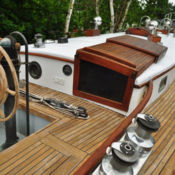 No Reserve -True Auction WORLD'S MOST PERFECT DESIGN ATKINS 40 FT GLOBAL CRUISER
No Reserve -True Auction WORLD'S MOST PERFECT DESIGN ATKINS 40 FT GLOBAL CRUISER
Model: 1984
Year: 1984
Location: Puyallup, Washington, United States
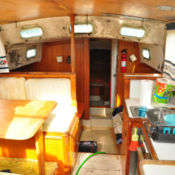 PERFECT VESSEL FOR COUPLE TO CIRCUMNATIGATE -GLOBALLY CAPABLE PILOTHOUSE CRUISER
PERFECT VESSEL FOR COUPLE TO CIRCUMNATIGATE -GLOBALLY CAPABLE PILOTHOUSE CRUISER
Model: 1969
Year: 1969
Location: Solomons, Maryland, United States
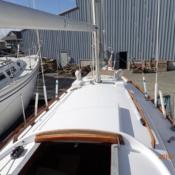 GLOBALLY RENOWED, FULL KEEL BRISTOL CRUISER -Perfect 4 Couple 2 Sail the World
GLOBALLY RENOWED, FULL KEEL BRISTOL CRUISER -Perfect 4 Couple 2 Sail the World
Model: 1974
Year: 1974
Location: Greenport, New York, United States
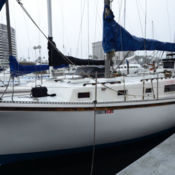 NO RSRV-SPACIOUS GLOBAL CRUISER- $8K Diesel Engine Runs Exlnt. PERFECT 4 ISLANDS
NO RSRV-SPACIOUS GLOBAL CRUISER- $8K Diesel Engine Runs Exlnt. PERFECT 4 ISLANDS
Model: 1974
Year: 1974
Location: Marina del Rey, California, United States
 Custom Tugboat 36' Converted River Tug, Single diesel Cruiser, Tour boat
Custom Tugboat 36' Converted River Tug, Single diesel Cruiser, Tour boat
Model: 1986
Year: 1986
Location: West Palm Beach, Florida, United States
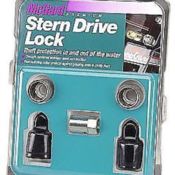 McGard 74019 Marine Twin Stern Drive Lock Set (7/16"- 20 Thread Size
McGard 74019 Marine Twin Stern Drive Lock Set (7/16"- 20 Thread Size
Year: 2014
Location: Richmond, British Columbia, Canada
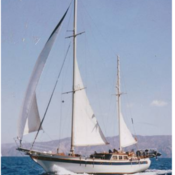 HUGE CLASSIC KETCH RIGGED GLOBAL PASSAGE MAKER OR LIVE-ABOARD - JUICY INTERIOR
HUGE CLASSIC KETCH RIGGED GLOBAL PASSAGE MAKER OR LIVE-ABOARD - JUICY INTERIOR
Model: 1978
Year: 1978
Location: Melbourne, Florida, United States
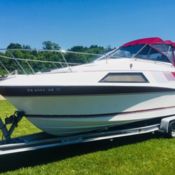 NO RESERVE! 1986 Carver 26 Montego Cruiser w/5.7L V8 26HP & Trailer, NO RESERVE!
NO RESERVE! 1986 Carver 26 Montego Cruiser w/5.7L V8 26HP & Trailer, NO RESERVE!
Model: 1986
Year: 1986
Location: James Creek, PA, United States
 Single Seat Tunnel Hull
Single Seat Tunnel Hull
Year: 1990
Location: Knoxville, Tennessee, United States
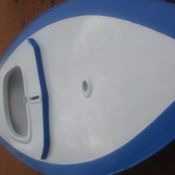 14' single person sailboat - Scorpion
14' single person sailboat - Scorpion
Year: 2008
Location: Woodland Park, Colorado, United States
